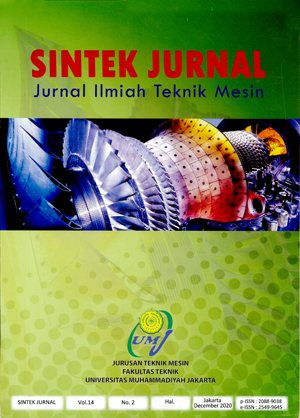IMPROVING THE EFFECTIVENESS OF PRIMARY ROLLING MACHINE WITH OEE AND SIX BIG LOSSES METHOD
Main Article Content
Abstract
Article Details
- Articles published in SINTEK JURNAL are licensed under a Creative Commons Attribution-ShareAlike 4.0 International license. You are free to copy, transform, or redistribute articles for any lawful purpose in any medium, provided you give appropriate credit to the original author(s) and SINTEK JURNAL, link to the license, indicate if changes were made, and redistribute any derivative work under the same license.
- Copyright on articles is retained by the respective author(s), without restrictions. A non-exclusive license is granted to SINTEK JURNAL to publish the article and identify itself as its original publisher, along with the commercial right to include the article in a hardcopy issue for sale to libraries and individuals.
- By publishing in SINTEK JURNAL, authors grant any third party the right to use their article to the extent provided by the Creative Commons Attribution-ShareAlike 4.0 International license.
References
Z. I. Martomo and P. W. Laksono, “Analysis of total productive maintenance (TPM) implementation using overall equipment effectiveness (OEE) and six big losses: A case study,” AIP Conf. Proc., vol. 1931, 2018, doi: 10.1063/1.5024085.
L. Hassani, “Ladan Hassani THE IMPACT OF OVERALL EQUIPMENT EFFECTIVENESS ON PRODUCTION LOSSES IN MOGHAN CABLE & WIRE,” vol. 9, no. 4, pp. 565–576, 2004.
N. S. Ningrum and A. Muhsin, “Line Machining Propeller Shaft Untuk Produk Flange Menggunakan Metode Overall Equipment Effectiveness ( Oee ) ( Studi Kasus Di Pt Hino Motors Manufacturing Indonesia ),” J. Optimasi Sist. Ind., vol. 9, no. 2, pp. 109–118, 2016, [Online]. Available: http://jurnal.upnyk.ac.id/index.php/opsi/article/view/2167.
I. G. A. Widyadana, “Pengukuran Overall Equipment Effectiveness ( OEE ) di PT Astra Otoparts Tbk . Divisi Adiwira Plastik,” J. Titra, vol. 3, no. 1, pp. 41–48, 2015, [Online]. Available: http://studentjournal.petra.ac.id/index.php/teknik-industri/article/download/2981/2686.
K. Hafiz and E. Martianis, “Analisis Overall Equipment Effectiveness (OEE) pada Mesin Caterpillar Type 3512B,” SINTEK J. J. Ilm. Tek. Mesin, vol. 13, no. 2, p. 87, 2019, doi: 10.24853/sintek.13.2.87-96.
D. Syamsuddin, D. E. Budiasih, A. Pamoso, and S. M. T. Si, “Analisis Overall Equipment Effectiveness ( Oee ) Dan Risk Based Maintenance ( Rbm ) Pada Mesin Huron Di Pt Xyz Overall Equipment Effectiveness ( Oee ) and Risk Based Maintenance ( Rbm ) Analysis on Huron Machine in Pt Xyz,” vol. 5, no. 2, pp. 2501–2508, 2018.
H. A. Prabowo and D. I. R, “Improve the Work Effectiveness With OEE (Overall Equipment Effectiveness) As the Basis for Optimizing Production,” Pasti, vol. IX, no. 3, pp. 286–299, 2019.
F. Alamsyah, “Analisis Akar Penyebab Masalah Dalam Meningkatkan Overall Equipment Effectiveness (OEE) Mesin Stripping Hipack III Dan Unimach DI PT PFI Firman,” J. OE, vol. VII, no. 3, pp. 289–302, 2015, [Online]. Available: http://publikasi.mercubuana.ac.id/index.php/oe/article/view/542/482.
R. Alfatiyah, S. Bastuti, and D. Kurnia, “Implementation of statistical quality control to reduce defects in Mabell Nugget products (case study at Pt. Petra Sejahtera Abadi),” IOP Conf. Ser. Mater. Sci. Eng., vol. 852, no. 1, 2020, doi: 10.1088/1757-899X/852/1/012107.
S. Bastuti, D. Kurnia, and A. Sumantri, “Analisis Pengendalian Kualitas Proses Hot Press Pada Produk Cacat Outsole Menggunakan Metode Statistical Processing Control (Spc) Dan Failure Mode Effect and Analysis (Fmea) Di Pt. Kmk Global Sports 2,” J. Teknol., vol. 1, pp. 72–79, 2018.
R. Alfatiyah and W. Marthin, “Redesign Kursi dan Meja Perkuliahan Dengan Metode Quality Function Deployment (QFD) Secara Ergonomis Di Program Studi Teknik Industri, Universitas Pamulang,” Pros. Semin. Ilm. Nas., pp. 76–88, 2017.
R. Alfatiyah, “Analisis Kegagalan Produk Cacat Dengan Kombinasi Siklus Plan- Do-Check-Action (PDCA) Dan Metode Failure Mode And Effect Analysis (FMEA),” J. Ilm. Dan Teknol. oleh Univ. Pamulang, vol. 2, no. 1, pp. 39–47, 2019.
S. Bastuti, “Analisis Kegagalan Pada Seksi Marking Untuk Menurunkan Klaim Internal Dengan Mengaplikasikan Metode Plan–Do–Check–Action (PDCA),” J. SINTEK, vol. 11, no. 2, pp. 113–122, 2017.
R. Sumaedi, “Analysis of Air Conditioner Precision ( PAC ) Machine Using Overall Equipment Efectiveness ( OEE ) Method ( Case Study at Data Center XYZ Company Jakarta ),” vol. 5, no. 1, 2020.
K. M. Cheh, “Analysis of Overall Equipment Effectiveness (OEE) within different sectors in different Swedish industries,” pp. 1–65, 2014, [Online]. Available: http://www.diva-portal.se/smash/get/diva2:903747/FULLTEXT01.pdf.
A. P. Herry, F. Farida, and N. I. Lutfia, “Performance analysis of TPM implementation through Overall Equipment Effectiveness (OEE) and Six Big Losses,” IOP Conf. Ser. Mater. Sci. Eng., vol. 453, no. 1, 2018, doi: 10.1088/1757-899X/453/1/012061.
D. Nusraningrum and E. G. Senjaya, “Over all Equipment Effectiveness ( OEE ) Measurement Analysis on Gas Power Plant with Analysis of Six Big Losses EQUIPMENT EQUIPMENT TOTAL BREAKDOWN 2017,” Int. J. Bus. Mark. Manajement, vol. 4, no. 11, pp. 19–27, 2019.
U. Mardono, A. Rohimah, and E. Rimawan, “Six Big Losses Approach and Kaizen Philosophy Implementation to Improve Overall Equipment Effectivenes ( OEE ) ( Case Study : PT . ABC , Areinforced Steel Manufacturer ),” vol. 3, no. 6, pp. 165–171, 2018.
A. Sutoni, W. Setyawan, and T. Munandar, “Total Productive Maintenance (TPM) Analysis on Lathe Machines using the Overall Equipment Effectiveness Method and Six Big Losses,” J. Phys. Conf. Ser., vol. 1179, no. 1, 2019, doi: 10.1088/1742-6596/1179/1/012089.


